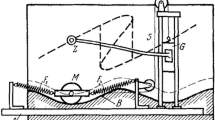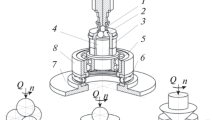Abstract
Frictional behavior in dry or boundary-lubricated tribosystems is commonly time-dependent. Examples include phenomena like running-in, scuffing initiation, adhesive transfer, coating wear-through, and lubricant starvation. Fundamental models for the sliding friction coefficient usually focus either on determining a steady–state value or on predicting periodic behavior like stick-slip. They often neglect the details of long- and short-period frictional transients, some of which are quite repeatable. In addition to generating heat, frictional work is known to be dissipated in several ways, including roughness changes, wear particle generation, tribomaterial evolution, and microstructural alteration. Pairs of materials can display identical average friction coefficients but significantly different wear processes because frictional work is dissipated differently from one pair of materials to the next. The attributes of friction-versus-time behavior for combinations of metals, ceramics, and polymers can be comprised of stages whose understanding may require the development of piecewise friction models that include wear. This paper discusses past work on the subject, exemplifies embedding a simple wear model into a friction-versus-time model, and indicates how friction process diagrams can play a role.



Similar content being viewed by others
References
Czichos, H.: Tribology–A Systems Approach. Elsevier Pub, Amsterdam (1978)
Blau, P.J.: Four great challenges confronting our understanding and modeling of sliding friction. In: Dowson, D., et al. (eds.) Tribology for Energy Conservation, pp. 117–128. Elsevier, UK (1998)
Meng, H.C., Ludema, K.: Wear models and predictive equations: their form and content. Wear 181–183, 451–457 (1995). doi:10.1016/0043-1648(95)90158-2
Bowden, F.P., Tabor, D.: Friction and Lubrication of Solids. Oxford Press, Oxford, UK (1986)
Suh, N.P.: Genesis of friction. Wear 69(1), 91–114 (1969). doi:10.1016/0043-1648(81)90315-X
Hokkirigawa, H., Kato, K.: An experimental and theoretical investigation of ploughing, cutting and wedge formation during abrasive wear. Tribology Int 21(1), 51–57 (1988). doi:10.1016/0301-679X(88)90128-4
Amamoto, Y., Goto, H.: Friction and wear of carbon steel near T1 transition under dry sliding. Trib. Intern. 39(8), 756–762 (2006). doi:10.1016/j.triboint.2005.07.001
Dobson, P.S., Wilman, H.: The friction and wear, and their inter-relationship, in abrasion of a single crystal of brittle nature. Brit. J. Appl. Phys 14, 132–136 (1990). doi:10.1016/0043-1648(90)90070-Q
Godet, M.: Third-bodies in tribology. Wear 136(1), 29–45 (1990)
Blau, P.J.: Friction Science and Technology, 2nd edn. Taylor and Francis/CRC Press, Boca Raton, Florida (2008). 420 pp
Lossie, C.M., Mens, J.W.M., de Gee, A.W.J.: Practical applications of the IRG transitions diagram technique. Wear 129(2), 173–182 (1989). doi:10.1016/0043-1648(89)90255-X
Blau, P.J.: Interpretations of the break-in behavior of metals in sliding contact. Wear 71, 29–43 (1981). doi:10.1016/0043-1648(81)90137-X
Blau, P.J.: Friction mechanisms and modeling on the macroscale. In: Bhushan, B. (ed.) Fundamentals of Tribology and Bridging the Gap Between the Macro- and Micro/Nanoscales, pp. 241–260. Kluwer Academic Publishers, Dordrecht (2001)
Blau, P.J., Whittenton, E.P.: Test of a rule of mixtures for dry sliding friction of 52100 steel on an Al–Si–Cu Alloy. Wear 81, 187–192 (1982). doi:10.1016/0043-1648(82)90315-5
Acknowledgments
The author wishes to express his gratitude for the advice and consultation of Prof. Ken Ludema over the years, and for his many contributions to tribology, especially in areas of boundary lubrication and automotive tribology. A portion of this research was sponsored by the U.S. Department of Energy, Office of Vehicle Technologies, and performed at Oak Ridge National Laboratory, managed by UT-Battelle LLC, under contract number DE-AC05-00OR22725.
Author information
Authors and Affiliations
Corresponding author
Rights and permissions
About this article
Cite this article
Blau, P.J. Embedding Wear Models into Friction Models. Tribol Lett 34, 75–79 (2009). https://doi.org/10.1007/s11249-008-9395-1
Received:
Accepted:
Published:
Issue Date:
DOI: https://doi.org/10.1007/s11249-008-9395-1




